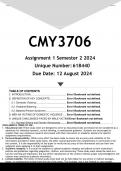CMY3706
Assignment 1 Semester 2 2024
Unique Number: 618440
Due Date: 12 August 2024
TABLE OF CONTENTS
1. INTRODUCTION .................................................... Error! Bookmark not defined.
2. DEFINITION OF KEY CONCEPTS ........................ Error! Bookmark not defined.
2.1. Domestic Violence ........................................... Error! Bookmark not defined.
2.2. Husband Battering ........................................... Error! Bookmark not defined.
2.3. Battered Person Syndrome .............................. Error! Bookmark not defined.
3. MEN AS VICTIMS OF DOMESTIC VIOLENCE ..... Error! Bookmark not defined.
4. UNIQUE CHALLENGES FACED BY MALE VICTIMSError! Bookmark not defined.
4.1. Societal Stigma and Gender Stereotypes ........ Error! Bookmark not defined.
DISCLAIMER & TERMS OF USE
1. Educational Aid: These study notes are designed to serve as educational aids and should not be considered as a
substitute for individual research, critical thinking, or professional guidance. Students are encouraged to
conduct their own extensive research and consult with their instructors or academic advisors for specific
assignment requirements.
2. Personal Responsibility: While every effort has been made to ensure the accuracy and reliability of the
information provided in these study notes, the seller cannot guarantee the completeness or correctness of all
the content. It is the responsibility of the buyer to verify the accuracy of the information and use their own
judgment when applying it to their assignments.
3. Academic Integrity: It is crucial for students to uphold academic integrity and adhere to their institution's
policies and guidelines regarding plagiarism, citation, and referencing. These study notes should be used as a
tool for learning and inspiration, but any direct reproduction of the content without proper acknowledgment and
citation may constitute academic misconduct.
4. Limited Liability: The seller of these study notes shall not be held liable for any direct or indirect damages,
losses, or consequences arising from the use of the notes. This includes, but is not limited to, poor grades,
academic penalties, or any other negative outcomes resulting from the application or misuse of the information
provided. ]
, For additional support +27 81 278 3372
TABLE OF CONTENTS
1. INTRODUCTION .................................................................................................... 7
2. DEFINITION OF KEY CONCEPTS ........................................................................ 7
2.1. Xenophobia ...................................................................................................... 7
2.2. Human Rights .................................................................................................. 7
3. PREVENTION OF XENOPHOBIA ......................................................................... 7
3.1. Policy Strategies .............................................................................................. 7
3.2. Humanitarian Strategies................................................................................... 8
3.3. Legal and Constitutional Strategies ................................................................. 8
3.4. Citizenship Empowerment and Educational Strategies .................................... 9
3.5. Technical and Media-Related Strategies ......................................................... 9
3.6. State-Civil Society Partnership ....................................................................... 10
3.7. Intergovernmental Strategies ......................................................................... 10
4. CONCLUSION ..................................................................................................... 11
5. REFERENCES ..................................................................................................... 11
, For additional support +27 81 278 3372
1. INTRODUCTION
Xenophobia, the deep-seated fear and hatred of foreigners, has become a significant human
rights issue in South Africa. Despite various interventions, xenophobic violence continues
to plague the nation, threatening the social fabric and undermining efforts towards peaceful
coexistence. This essay will discuss the strategies currently employed to address
xenophobia in South Africa, focusing on policy, humanitarian, legal and constitutional,
citizenship empowerment and educational, technical and media-related, state-civil society
partnership, and intergovernmental strategies. By evaluating these strategies, we can better
understand their effectiveness and identify areas for improvement.
2. DEFINITION OF KEY CONCEPTS
2.1. Xenophobia
Derived from the Greek words "xenos" (stranger or foreigner) and "phobos" (fear),
xenophobia is defined as the deep hatred of immigrants by nationals of the host state
(Dassah, 2015 in Akinola, 2018:1). It encapsulates all forms of discrimination against
individuals perceived as "different" due to their foreign origin or nationality.
2.2. Human Rights
Human rights are the basic rights and freedoms that belong to every person in the world,
from birth until death. These rights include the right to life, dignity, equality, freedom of
movement, and the right to live free from discrimination.
3. PREVENTION OF XENOPHOBIA
3.1. Policy Strategies
The South African government has adopted several policy strategies to prevent xenophobia.
One key approach involves engaging various stakeholders, including provincial
governments and communities, to foster a unified response. This integrated approach aims




